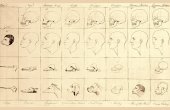Gender Has a History and It’s More Recent Than You May Realize

“Penis envy,” that old chestnut offered by Freud, has long struck so many people as evidence of Freud’s own obsession with the male organ as the be-all-and-end-all. To imagine that everything concentrates on genitals — the penis, most of all — just seems juvenile.
Yet in a way so familiar to us all, what awaits a newborn in the U.S. proves a lasting obsession with . . . the penis. You have one or you don’t. We see it or we don’t. The visibility of this organ is the chief driver of sex assigned at birth. We put our eyes on the surface of the baby — and give it a read. If all looks as expected, we assign a word that “is” the baby’s sex.

This life-defining word awaits each baby. The word goes on paper and is spoken in the air, but there’s no way to affix it to the body (short of tattooing it). The body is physically separate from its word. But the word will hover or function like a cone pulled down on the body. All without the baby’s consent. Only later will the word get inside the child to become a word that stands for the child itself (if the child will stand for it).
Even more dramatically, the child’s sex-word, pronounced at birth, is a gender-word: “it’s a girl!” or “it’s a boy!” The idiom is not “it’s a male!” or “it’s a female!” An entire world of cultural assumptions is rolled up into the word rolled onto the baby and its genitals.
And yet Anne Fausto-Sterling, the renowned biology and sex/gender expert, succinctly states: “By birth, the baby has five layers of sex.” That’s right: There are fetal layers to the baby’s sex, to put the matter oddly. Even more strikingly, “these layers do not always agree with each other.” Here’s the beginning, one is tempted to say, of our not agreeing with ourselves biologically. Parts of our body disagree with other parts. Baby sex-layers, moreover, is a concept Fausto-Sterling takes from famous researcher John Money — and Money, we will see in a moment, plays a critical role in what eventually gets called “gender.”
The story of gender is a crucial gathering. A veritable crisis of interpretation. Then, a turning point.
The naming of sex isn’t luscious, but it’s crucial. You should know your layers (what they’re said to be):
Layer one is called “chromosomal sex-layer 1,” comprising, no surprise, the combination of X and Y chromosomes fetuses receive when an egg and sperm join. Layer two is “fetal gonadal sex” (testes or ovaries or, in some cases, a combination), followed by a third layer: “fetal hormonal sex” (resulting from hormones released by the gonads). This fetal hormonal sex “contributes to the formation” of layer four, named the “internal reproductive sex” — the one we don’t see — and one that isn’t “one,” since for (the people called) males it’s the grouping of vas deferens, prostate, and epididymis and for (the people called) females it’s the collection of uterus, cervix, and Fallopian tubes. (Whether your “man or woman on the street” could name all these parts of their internal sex is an interesting question.) Lastly, generally around the fetus’s fourth month of development, the fifth layer forms as “the hormones complete their job” in shaping the fetus’s external genitalia: penis, scrotum, vagina, clitoris, and any number of variabilities and “genital ambiguities.”
To state the obvious, adults who name the baby with a word, “girl” or “boy,” see only one of the five sex-layers.
The others are invisible to the naked eye. Who knows how many discrepancies between and among the layers of sex go undetected. (You might be discrepant with yourself and not know it.) In the past, should a “problem” — disagreement (!) — arise, steps might well be taken to force the baby to agree with itself. The history of intersex people, with all its profound implications, sits right here. And given the incidence of intersex, which might be as high as one in 60 people, it’s a bigger history and bigger population than is often recognized. Also, a bigger struggle to be accorded human rights, instead of deemed a problem.
The overriding historical measure of this “problem” has been the viability of a baby’s penis. Until recently, if a child would “suffer” an insufficient penis, something would be done: genital surgery, some form of treatment, and/or switching the word for the sex. A “boy” with a “bad” penis might be named and raised a “girl.”
All of which takes us to a sixth layer. What is named “gender.” It’s as if binary sex (itself a five-layered process) passes its credentials to binary gender — thus the presumption that gender is a twosome, named as either “girl” or “boy.” In the words of Fausto-Sterling: “this identification” of the child’s sex from the child’s “external genital anatomy” then “initiate[s] a social response that be[gins] the gender socialization of the newborn.”
Welcome to the gender fort. The “social response” to a baby is “intense.” So intense, we learn, that our reading of its genitals, to which we pin a word, causes our building of a fort around this reading. It’s no joke. Fausto-Sterling calls this socialization “gender fortification.” The word “boy” or “girl,” however cone-like, however body-sheath-like, is evidently not enough for us. We act as if we have to fortify it at every turn. So here come clothing, colors, toys, and hair. Nonetheless, the gender system has been surrounding the newborn baby since before its birth. That’s why the name of the “gender-reveal party” is, yes, so revealing. They are indeed revealing gender, as they say.
So how in the world did gender come to be?
You might well imagine we’ve always had gender. (It might hark from the dawn of time?) Or you might be savvy and know it’s historical but find it hard to pinpoint. You are not alone. Gender has a history and it’s more recent than many people realize.
Many expert thinkers are likely to imagine that feminist writers invented gender. Many contemporary feminists may think so. Indeed, why wouldn’t they? It would be logical — and, frankly, appealing — to believe that women seeking equality would champion a concept that implies change. Whereas sex is given, the story often goes — you have certain genitals by which you are sexed — gender is behavior and social conditioning and learned ways of being that we can unlearn, unmake, undo. Gender is distinctive from sex, it’s been claimed.
Seventies’ and ’80s’ feminists are certainly part of gender’s story. In ways more intriguing than just described. But a different history — of intersexed and transgender children — what was done to them — tells a starker tale. (In case you could use a brief reminder: Intersex children are born with features — genitals, hormones, gonads, or chromosomes — that do not “fit the typical definitions of male or female” bodies. Transgender children do not feel right in their sex assigned at birth.) This bleaker history happens over decades (five, to be exact), culminating in gender’s creation as a concept in the 1950s, so as, some would say, to save the binary division of sex (sex as male and female) from its own collapse.
Money Made Gender
The moral of the story: Beware when science wants you.
Gender gets made from children’s having something science found valuable. Jules Gill-Peterson, in her recent book “Histories of the Transgender Child,” tells us how it all went down. It’s not that medicine made trans children. It’s that children’s sense of themselves as something-other-than-what-they-were-assigned got taken up by medicine — across five decades of medical research (1900–1950) — before the crowning of the thing called gender.
The newness and now-ness of “trans” kids as a phenomenon is a “myth.” They are not recent — not as you might think.
This means the newness and now-ness of “trans” kids as a phenomenon is a “myth.” They are not recent — not as you might think. They have a history under the eyes of doctors and parents, as Gill-Peterson carefully shows. Just as crucially, they didn’t need medicine in order to grasp their determined wishes.
What happened, then?
Intersex children and transgender children (not yet named as such) held something that would prove quite dear to U.S. science in the 20th century: the capacity to be transformed by medicine. Indeed, these children became “living laboratories,” writes Gill-Peterson. They were deemed “plastic” enough to be changed — first through surgeries, later by hormones — often in the name of “correction.” Their “peculiar” suffering could be studied, treated, and corrected. If they disagreed with their bodies, agreement could be fashioned. Medically, surgically.
If they were white. The children not selected, rarely presented, never sought out for medical treatment (however highly torturous) were children of color.
They did not hold value in the same way. Decades of eugenic thought and aims were deeply in the ferment of these research settings. Besides, we learn, “the few black intersex children and families” seen in the clinics and institute contexts (at Johns Hopkins, quite specifically) “were regarded by staff as more ‘difficult,’ combative, irrational, and . . . disposable.” Thus, as Gill-Peterson powerfully claims, “the medicalization of trans life,” right from the beginning, “fundamentally racialized it.”
This is where gender takes center stage. A crisis was brewing. Due to this cadre of certain white children who didn’t fit the measures of binary sex, biology and medicine were facing a cataclysm. Those most knowledgeable understood the plastic nature of the body — along with the possibility of its not matching itself at all levels. They of all observers feared that the proof for binary sex was crumbling before them, given that a series of “predictors” for male or female status didn’t reliably predict at all. Chromosomes were no sure ground whatsoever; having testes or ovaries didn’t do it; even hormones, for complicated reasons, didn’t prove predictive; and genitals or secondary sex characteristics could clearly go awry.
Gender to the rescue. In the most circular but interesting of ways, gender is invented to shore up sex. Scholar John Money is the king of the inventors. King of the interpreters. For gender’s own story is not a fly-by-night creation by a singular person, waving a wand — though there’s a powerful man in this story. The story of gender is a crucial gathering. A veritable crisis of interpretation. Then, a turning point.
In the most circular but interesting of ways, gender is invented to shore up sex.
The story to be gleaned from reading Gill-Peterson can be put this way. Money, with his colleagues, largely rolled 1950’s norms over scientific data so as to defend against what that data showed. Without enough interest, in the deepest sense, to listen to children or even inform them about their treatment, Money embraced changeability with one hand while grasping at fixity with the other.
Here’s how he did it. To defeat the crisis that humans “were naturally . . . sexually indeterminate,” Money argued that children are actually born plastic and remain plastic for a certain time. Hence, you can use surgery and hormones to “correct” their bodies and “finish” their genitals, if their genitals prove ambiguous. After this time (around 18 months), children must grow in developmental channels, “either male or female.” Why must they do so? In order “to prevent” their suffering from “social stigma” or psychological distress (from their not complying with their gender fort). These two channels for children’s development — only two — are what Money then called “gender.”
There’s your circle. Society, ignorant of medical research, makes a stigma out of something our bodies do quite naturally: not conform to a sexual binary. Thus, society’s enforced binary corrects a problem of its own making. And medicine complies, against its own research. Quite unlike later feminist notions — that gender is dynamic, changing, changeable, and capable of undermining social norms and their stigmatizing ways — Money’s “gender” argued for something much more fixed and stigmatizing, all while purporting to sidestep stigma.
Money’s not alone in tangled thought. Many different feminists have tried their hand at parsing sex/gender, from the 1960s to the present day. Among the questions implicitly tackled: Should we seek to equalize the terms man and woman? But how could they be equalized without our changing their meanings so completely that they cease to mean? Would this be the point? Or should we open up positive meanings, powerful meanings, for the term woman so that it starts to receive its due? (Largely, it has served as a photographic negative of the term man.) How can “woman” come into its own if it’s locked in dynamic tension with “man”? Can we crash the system of sex and gender by multiplying terms? Or can we only reveal the comedy, the theater, of gender as required performance? What if the category woman itself excludes many women?
Taking Stock (Again)
No one really knows how genders are changing day by day. We can spot leaps — or shifts — as we look back. But we are riding the wave coming at us, which can be gleeful and cruel by turns.
We can innovate and fantasize. Organize. Push for system change. We can hope for herd immunity. We can change from tragedy. We can minute by minute fail norms.
This failure isn’t nothing. It can be painful — can cost you your life. It can be happy. Also ephemeral. Gender does change because we fail its orderings. Jacqueline Rose, writing at the time of the philosopher-feminist Luce Irigaray, made this point: “The unconscious constantly reveals the ‘failure’ of identity. . . . [T]here is no . . . position for women (or for men) which is ever simply achieved. . . . ‘Failure’ is not a moment to be regretted. . . . Instead ‘failure’ is something endlessly repeated and relived moment by moment throughout our individual histories.”
Gender has been changing since it was invented. Gender’s changeability isn’t really new — but in perceiving it, people are advancing it, sometimes fighting it, and also undeniably accelerating it. Gender, let’s remember, was invented in response to certain recognitions. Biology and medicine, after all, came to realize in their way that the binary of sex was imposed upon a range of human bodies and their lived desires. Fascinating, fraught, and intimate to everyone, gender increasingly has our attention as something newly morphing. Prepare to enter a story that is yours.
Kathryn Bond Stockton is Distinguished Professor of English and inaugural Dean of the School for Cultural and Social Transformation at the University of Utah. She is the author of, among many other books, “Beautiful Bottom, Beautiful Shame: Where ‘Black’ Meets ‘Queer,” “The Queer Child, or Growing Sideways in the Twentieth Century” (both published by Duke University Press), and “Gender(s),” from which this article is adapted.



